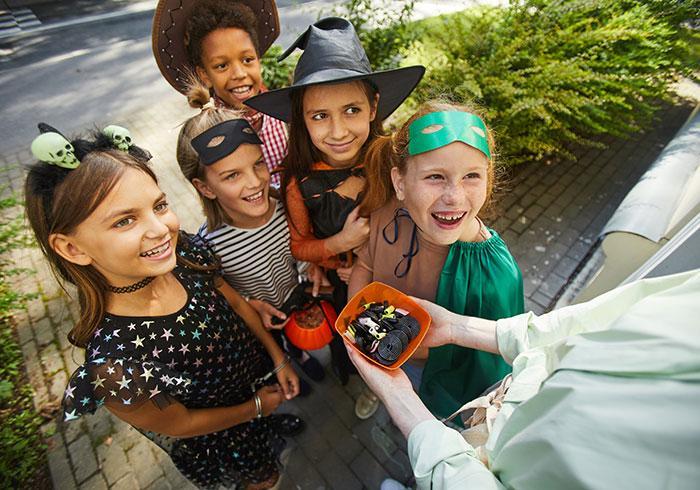Halloween is a time for all the costumes, cobwebs, and carved pumpkins, and for kids, Halloween can be one big sugar rush where it’s all about the candy. Whose house has the best candy? How much can you carry? What should I eat first? Children (and adults) with diabetes can still participate without sending their blood glucose (blood sugar) levels soaring.
Can my child with diabetes go trick-or-treating?
Good news! Trick-or-treating isn’t off-limits. Diabetes shouldn’t keep your children from having regular childhood experiences. High blood glucose is a concern, but you can play it safe by allowing your child to eat candy only once they have returned home. There, you can help them with how much they can have and, if needed, make sure they dose the correct amount of insulin for the carbs in the candy.
In fact, allowing your child to have some candy can be a good thing. Completely restricting anything makes it taboo and increases the chances of your child sneaking around to get it.
Celebrating at Home
While you probably want your child to celebrate the holiday the same way other kids do, there are ways to take the focus off sweets—it’s good for the whole family, too. Try:
- Hosting a costume party where the kids are the stars instead of the treats
- Invite your child’s friends to carve jack-o’-lanterns
- Gather family and friends to bob for apples, make papier-mâché pumpkins, or paint their faces like goblins or ghouls
When the party is at home, you can control the food, swapping candy and other sugary treats for healthier, but still festive, fare. It’s about focusing on the other aspects of Halloween that kids enjoy—the costumes and celebration—instead of just the candy.

Tips for a Healthier Holiday
- As for the massive bag of candy most kids tote home after trick-or-treating, you can “buy” your kids’ candy from them with cash (which they can use for toys or games) or trade it directly for toys or trinkets.
- Take their candy haul as an opportunity to help treat future cases of low blood glucose (hypoglycemia) by setting aside any non-chocolate sweets to raise blood glucose. Or, you can let your children keep a handful of candy, then set aside the rest. Overnight, you can secretly replace it with a gift or toy, attributing the switch to a mythical character. You can donate the remaining candy to a children’s hospital for kids who are too ill to trick or treat.
- Experts recommend buying small toys—like pencils, plastic rings, and mini containers of Play-Doh—to hand out in place of candy. At the end of the night, you won’t be left with buckets full of sweets that will tempt both you and your children.
- If you’re an adult with diabetes but want to give out candy, purchase sweets you don’t like. If Skittles don’t do it for you, stock up on those to avoid temptation. And if you live with diabetes but don’t have kids begging to celebrate the holiday, you can form your own holiday ritual. Instead of giving out candy, make a tradition of going to dinner with close friends, seeing a movie, or hosting a Halloween cocktail party.
- After the festivities, kids who take home a sack brimming with sweets may be tempted to eat it all at once, but portion control is key. So set a rule as to how many pieces of candy your child can eat each day (as long as their blood glucose isn’t already high) and stick to it. If you have other children that don’t have diabetes, have everyone follow this rule. It’s an extra step the whole family can take to make sure your child with diabetes doesn’t feel left out.
Remember, have a Happy Halloween!
Above all, it’s important to remember that even with diabetes, no holiday foods are forbidden. Enjoy treats in moderation, but keep in mind that there’s more to October 31 than sweets. You’ll enjoy the holiday most when your focus is on friends, family, and celebration—instead of what you can or cannot eat.
Candy Nutrition Information
Here’s a handy guide to figure out the nutrition information of candies that might not have a nutrition label.
- Snickers, fun size: 80 calories, 4 grams fat, 10.5 grams carbs
- 3 Musketeers, fun size: 63 calories, 2 grams fat, 11 grams carbs
- 3 Musketeers, mini: 24 calories, 0.7 grams fat, 5 grams carbs
- Skittles Original (fun size mini): 60 calories, 0.5 grams fat, 14 grams carbs
- Candy corn, 1 oz.: 100 calories, 0 grams fat, 25.6 grams carbs
- Milky Way, fun size: 80 calories, 3 grams fat, 12 grams carbs
- Milky Way, mini: 38 calories, 1.6 grams fat, 6 grams carbs
- Almond Joy, snack size: 80 calories, 4.5 grams fat, 10 grams carbs
- Hershey’s Kiss, 3 pieces: 67 calories, 4 grams fat, 8.3 grams carbs
- Kit Kat, fun size: 60 calories, 3 grams fat, 8 grams carbs
- Peanut M&M’s, fun size: 90 calories, 5 grams fat, 10.5 grams carbs
- M&M’s, fun size: 73 calories, 3.3 grams fat, 10.6 grams carbs
- York Peppermint Patty (mini): 50 calories, 1 grams fat, 11 grams carbs
- Tootsie Roll: 23 calories, 0 grams fat, 4.6 grams carbs
- Charms Blow Pop: 60 calories, 0 grams fat, 17 grams carbs
- Jolly Rancher: 23 calories, 0 grams fat, 5.6 grams carbs
- Smarties roll: 25 calories, 0 grams fat, 6 grams carbs
Nutrition information is shown per piece of candy or per bag for appropriate items (such as M&M’s).
If you have any additional questions or concerns, please visit the manufacturer’s website.
